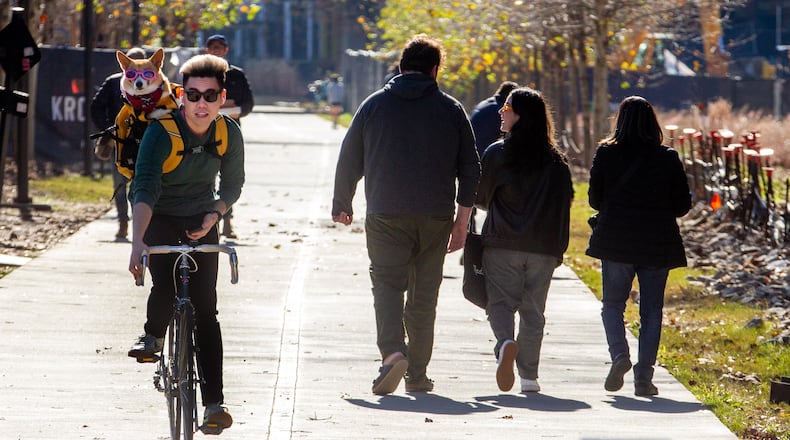Light rail on a key segment of the Atlanta Beltline could cost twice as much as originally projected, a new study has found.
The cost of building 3 miles of rail from Ponce City Market to MARTA’s Lindbergh station on the northeast side of Atlanta would cost an estimated $286.5 million to $448.2 million, depending on the route, the MARTA engineering study found. That’s far more than the $171.6 million the agency estimated three years ago.
A 4-mile segment south of Ponce City Market also would cost substantially more than originally estimated, according to the study.
The study found several feasible routes for light rail north and south of the market. But the cost estimates may make light rail on the Beltline too expensive to compete successfully for crucial federal funding, said Manjeet Ranu, MARTA’s chief of capital programs.
Ranu said further study is needed over the next two years. And a final decision on whether to pursue light rail or another type of transit — such as bus rapid transit — would be up to the MARTA board and Atlanta officials.
Matthew Rao, chair of the group Beltline Rail Now, said the study confirms light rail is feasible on the Beltline. What’s lacking, he said, is MARTA’s will to complete the project.
“The Beltline has been studied for 20 years at this point,” Rao said. “You need to just decide. (Newly elected Mayor Andre Dickens) needs to say, ‘We will build the Atlanta Beltline.’ ”
The engineering study comes as MARTA moves forward with plans for a $2.7 billion Atlanta expansion made possible when city voters approved a half-penny sales tax for transit in 2016.
Three years ago, the MARTA board approved a list of projects it plans to build with the sales-tax money. It included 29 miles of light rail along Campbellton Road in southwest Atlanta, the Clifton Corridor to the Emory University area and portions of the Atlanta Beltline.
Rail on Campbellton Road is already in doubt. Earlier this month, MARTA announced it would recommend bus rapid transit for the Campbellton corridor, citing its relatively low cost and quick construction timetable. The proposal has sparked a backlash from some southwest Atlanta residents, who say they were promised rail.
MARTA also would likely face a significant backlash if it abandons plans for light rail on the Beltline.
Rail has been a key facet of the Beltline since it was conceived in a master’s thesis by then-Georgia Tech student Ryan Gravel in 1999. Gravel envisioned converting abandoned rail lines around the heart of Atlanta into a transit, trail and parks loop that would connect and reinvigorate city neighborhoods.
Atlanta is on track to complete the full Beltline trail by 2030. But transit has not materialized.
MARTA plans to extend the Atlanta Streetcar east to Ponce City Market by 2027. That extension would include the first stretch of rail on the Beltline. Last year, the agency commissioned an engineering feasibility study of rail north and south of the market.
That study will be completed soon. But a draft obtained by The Atlanta Journal-Constitution shows three feasible alignments of light rail from Ponce City Market to Lindbergh.
All three would skirt Piedmont Park on the way to I-85. From there, two routes would generally follow existing MARTA right of way under I-85 to Lindbergh. A third heads east along the interstate, running in street traffic for part of the way.
Low-end cost estimates range from $286.5 million to $366.7 million, depending on the route. High-end estimates range from $350.2 million to $448.2 million.
In an interview, MARTA’s Ranu said the higher costs are a function of more detailed information obtained in the latest study, including the cost of specific bridges, buildings and other facilities.
The estimates do not include costs such as right of way, support facilities and transit vehicles. And the estimates may change as more detailed engineering work is completed.
The study also found three feasible routes to extend light rail south from Ponce City Market to the southside Beltline trail. Two routes would skirt the CSX Hulsey Yard to the west, while a third would cut through a tunnel beneath part of the rail yard.
Cost estimates for rail on the southeastern part of the Beltline range from $163.7 million to $269.9 million. MARTA’s original estimate was $109.5 million.
Although Beltline rail has not yet materialized, it has powerful advocates. Dickens has said he supports rail on the Beltline. U.S. Transportation Secretary Pete Buttigieg also has expressed support.
Shaun Green, senior transportation engineer at Atlanta Beltline Inc., which oversees the trail-and-transit project, said the cost estimates are “in the ballpark of what we see as reasonable.” He said the study is a high-level analysis of routes, not a final verdict on whether light rail makes sense.
“It’s the first step of many,” Green said. “This is not the end. This is the absolute beginning of it.”
Rao, the transit advocate, said more expensive projects than the Beltline have received federal funding.
“We said, with our vote, we want a light-rail system in the city of Atlanta,” he said. “And we want light rail on the Beltline.”
Atlanta Beltline: What’s next
What’s new: MARTA is completing a feasibility study of light rail on two segments of the Atlanta Beltline.
What’s next: When the study is completed, MARTA will begin more detailed studies needed before it can pursue federal funding of the project.
About the Author
The Latest
Featured


